12 Best Native Plants for Massachusetts
BY NICKI DESTASI | JUNE 6TH, 2023 | LAWN CARE, MASSACHUSETTSMassachusetts may be one of the smallest states in the union. But with its rich history, an abundance of universities, and breathtaking fall foliage, this state has got it going. And don’t forget about the native plants. From wildflowers to perennial trees, the Bay State has tons of beautiful native plants. So if you want a stunning landscape, choose one of these 12 best native plants for Massachusetts.
Choosing native Massachusetts plants for your landscape has several benefits, including:
- Native plants are low-maintenance because they naturally thrive in the local climate.
- Beneficial wildlife like bees, butterflies, and birds are attracted to most native plants.
- Native plants reduce chemical pollutants that harm local ecosystems by needing fewer pesticides and fertilizers than non-natives.
In this article, we’ll cover:
- Beach Plum
- Black Chokeberry
- Butterfly Weed
- Common Elderberry
- Eastern Elderberry
- Highbush Blueberry
- New England Aster
- New Jersey Tea
- Pearly Everlasting
- Red Maple
- Spotted Wintergreen
- Trumpet Honeysuckle
- How to Choose Native Plants for Your Massachusetts Landscape
- FAQ About Native Massachusetts Plants
- Where to Find Native Plants in Massachusetts
12 Native Plants for Your Massachusetts Yard
When Red Sox spring training rolls around, you should start thinking about which plants you want in your garden. Here are 12 of the best native plants for your Massachusetts landscape:
1. Beach Plum (Prunus maritima)
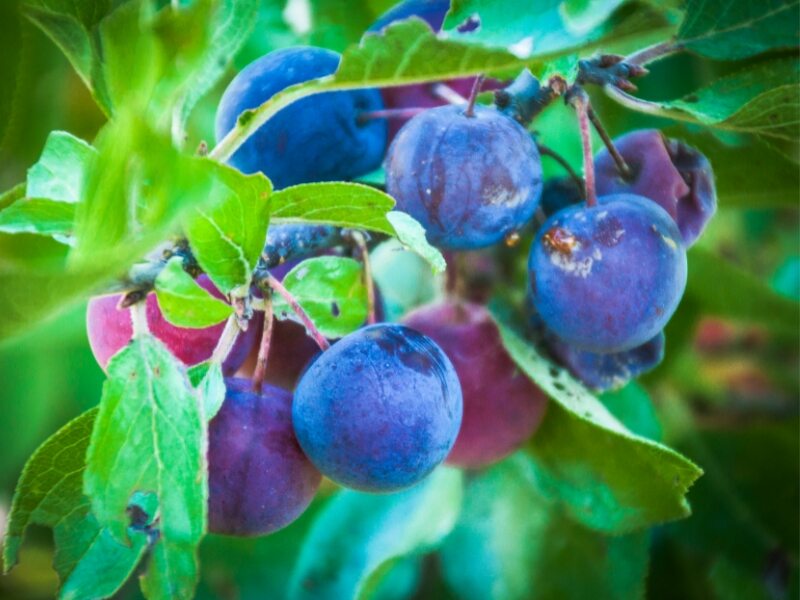
Photo Credit: KenWiedemann / Canva Pro / License
Part of the rose family, the beach plum naturally grows along the East Coast – from New Brunswick down to Virginia. It prefers the salty soil near the beach but happily grows further inland into western Massachusetts. You can propagate it from soft-wood clippings, but it also can be grown from seed using cold stratification.
This dense, rounded shrub with glossy, dark green leaves attracts various pollinators, including bees. Blooming from April through June, it produces small, white flowers that can be single or double. These flowers have multiple long anthers, giving them a somewhat fuzzy appearance. And from August to October, the shrub produces dull purple to crimson fruits that attract wildlife.
- Growth habit: Shrub
- USDA Hardiness zones: 3a-8a
- Mature size: Usually up to 8 feet, but rarely grows to 12 feet
- Duration: Perennial
- Foliage: Deciduous
- Sunlight needs: Full sun
- Soil preferences: Grows well in either dry or moist soil and prefers sandy or gravelly, well-drained soils
- Water needs: Moderate
- Potential hazards: While this shrub’s fruit is edible, its leaves and seeds produce hydrogen cyanide which is toxic in large quantities.
2. Black Chokeberry (Aronia melanocarpa)
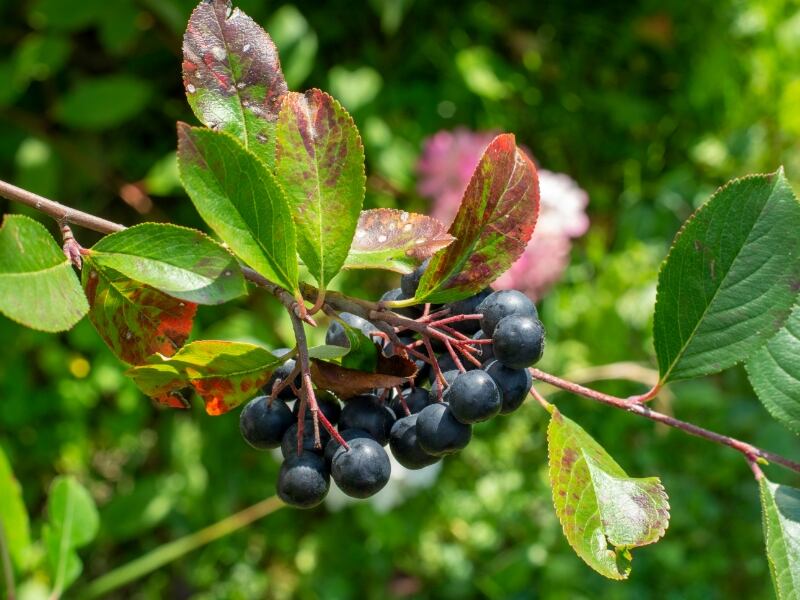
Photo Credit: Stefan Sutka / Canva Pro / License
A small and mound-shaped shrub, the black chokeberry has dark green, finely toothed leaves that turn a vibrant crimson in the fall. From March to June, the shrub produces five-petaled white flowers with pink anthers, followed by blackish-purple berries. The black chokeberry features multiple stems adorned with reddish-brown bark. This suckering plant tends to produce multiple base shoots, which require regular trimming to maintain its desired shape.
Native to regions east of the Mississippi River, excluding Florida, the black chokeberry thrives in its natural habitat. While its berries are too tart to be consumed raw, they can be cooked to create jams, jellies, and even wine. If you want to cook these berries, harvest them as soon as they ripen, or birds will steal them.
- Growth habit: Shrub
- USDA hardiness zone: 3-8
- Mature size: Up to 6 feet tall
- Duration: Perennial
- Foliage: Deciduous
- Sunlight needs: Full sun to partial shade
- Soil preferences: Moist, acid soils
- Water needs: Moderate
- Potential hazards: Berry consumption can cause diarrhea or constipation in some people.
3. Butterfly Weed (Asclepias tuberosa)
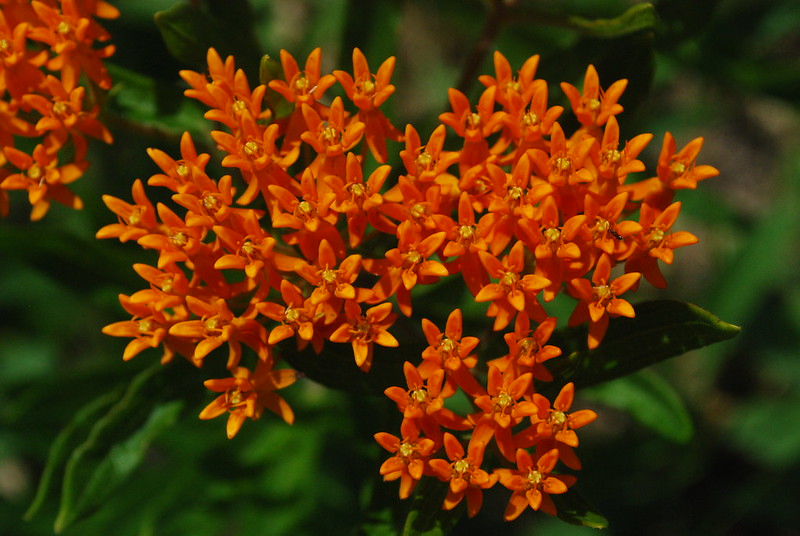
Photo Credit: Joshua Mayer / Flickr / CC BY-SA 2.0
A staple in many home gardens, the butterfly weed has a distinct yet beautiful flower structure. Its petals gracefully arch backward, creating a stunning display that showcases the vibrant center. While the flowers are typically bright orange, some varieties produce red or yellow blooms.
Also known as pleurisy root or orange milkweed, butterfly weed finds its roots in the New England region, stretching all the way down to Florida. It attracts butterflies, moths, hummingbirds, native bees, bumble bees, and honey bees. Note, though, that butterfly weed attracts aphids and ladybugs. But they can be removed with a soapy water spray.
- Growth habit: Wildflower
- USDA hardiness zone: 4-10
- Mature size: 1-2 feet
- Duration: Perennial
- Foliage: Deciduous
- Sunlight needs: Full sun
- Soil preferences: Prefers well-drained sandy soils
- Water needs: Low – can tolerate drought
- Potential hazards: If consumed in large quantities, its roots and sap can cause vomiting, stupor, weakness, and spasms. But when chewed (not swallowed) or steeped for tea, it can help with diarrhea (tea), bronchitis, pleurisy, and other pulmonary ailments (chewed).
4. Common Elderberry (Sambucus canadensis)
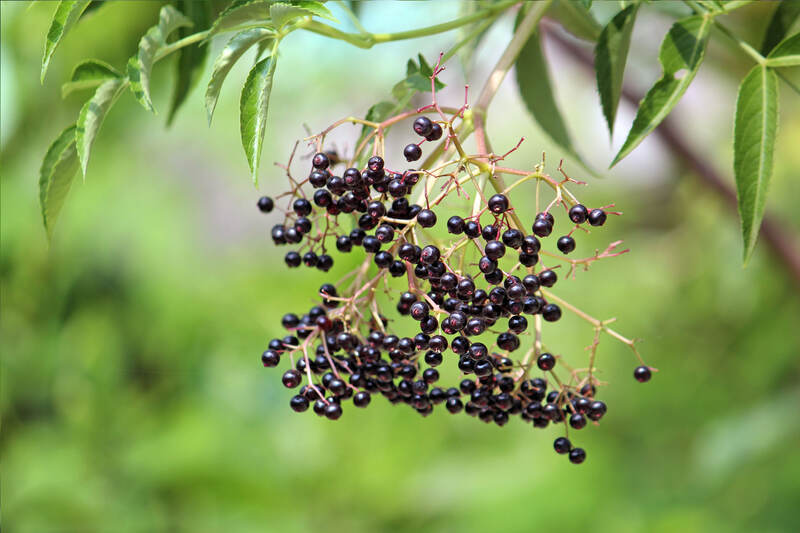
Photo Credit: Rison Thumboor / Wikimedia Commons / CC BY-SA 4.0
The common elderberry is an interesting large shrub with many long thin shoots that sprout from the base. A very fast grower, it will need to be pruned regularly. The leaves are flat, egg-shaped, narrow-toothed, dark green, and up to 12 inches long. Its tiny white clustered flowers bloom from May to July before becoming black to dark purple berries in late summer.
Elderberry shoots were used to craft flutes by boring the spongy white center. Later, Native Americans used the plant for several medicinal purposes. And today, it’s used to make jelly and wine. This perennial shrub attracts butterflies, bees, birds, small mammals, and deer. It grows best from cuttings but can grow from sulfuric-acid-treated seeds.
- Growth habit: Shrub
- USDA hardiness zone: 3-7
- Mature size: Up to 12 feet tall
- Duration: Perennial
- Foliage: Deciduous
- Sunlight needs: Part Shade
- Soil preferences: Prefers rich, moist, slightly acid soil but tolerates a wide variety of wet to dry soils.
- Water needs: Moderate
- Potential hazards: Consuming unripe or uncooked berries can cause nausea, vomiting, and diarrhea.
5. Eastern Bluestar (Amsonia tabernaemontana)
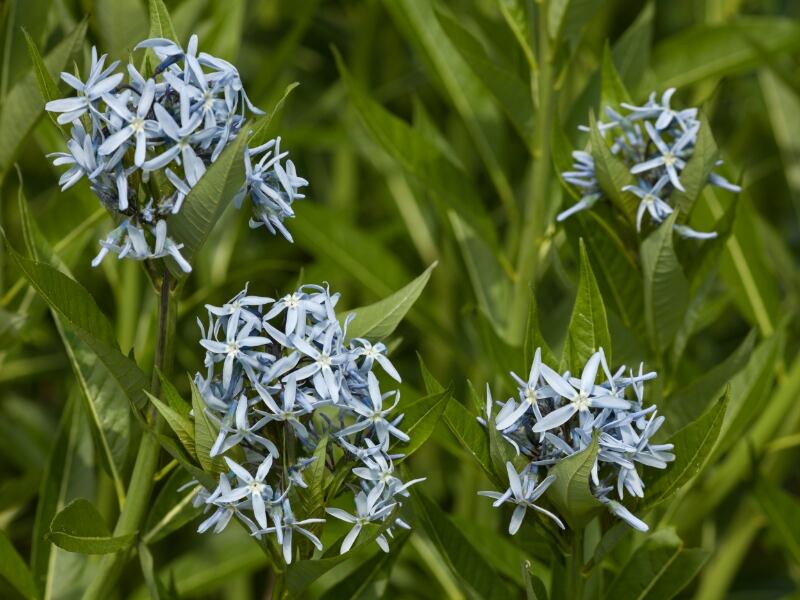
Photo Credit: Andyworks / Canva Pro / License
As the common name suggests, eastern bluestar is notable for its five-petaled, star-shaped, tubular blue or purple flowers. The lance-shaped dark green leaves turn golden yellow in the fall. It’s native to the Southeast, from Massachusetts down to Florida. They typically grow from seeds but won’t flower until the second year.
Also called blue dogbane, eastern bluestar provides the perfect habitat for beneficial fauna. Blooming from March to May, the flowers provide a nectar source for carpenter bees, hummingbirds, butterflies, and moths. Moreover, it’s resistant to most pests, diseases, and deer.
- Growth habit: Herb
- USDA hardiness zone: 3-11
- Mature size: Up to 3 feet
- Duration: Perennial
- Foliage: Deciduous
- Sunlight needs: Part Shade
- Soil preferences: Wet to moist, sandy soils
- Water needs: Moderate to high
- Potential hazards: Non-toxic to humans or pets – it has latex sap which can irritate the skin and affect individuals with a latex allergy
6. Highbush Blueberry (Vaccinium corymbosum)
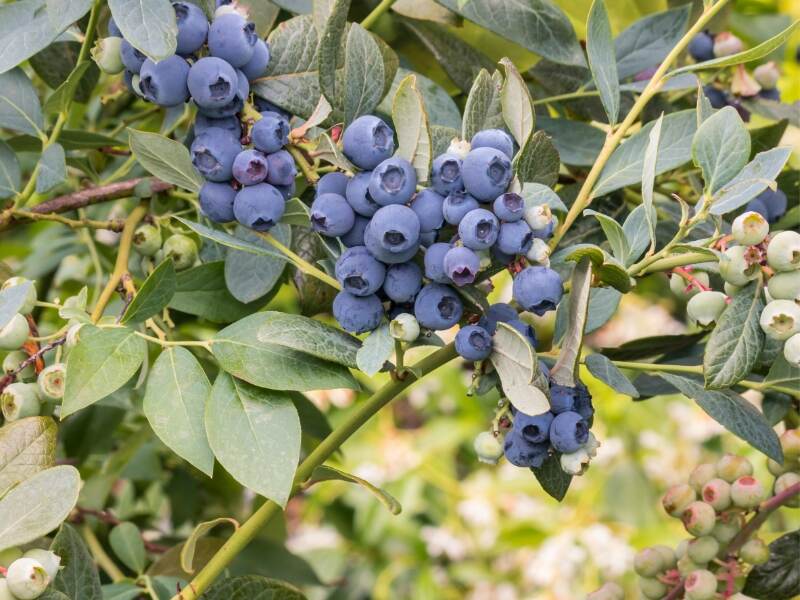
Photo Credit: PatrikStedrak / Canva Pro / License
One of nearly 150 species, the highbush blueberry has an abundance of stems and thin green and red branches that create a sizable dense shrub. In the early spring, leaves blossom with a reddish-green hue that turns blue-green in early summer and red, yellow, orange, and purple in fall. The white or pink, dangling, bell-shaped flower clusters bloom from March through June.
In late July through mid-August, yummy blueberries will ripen for the picking. Plant it in your shade garden so you and your loved ones can pick the berries to munch on or add to your favorite baked good or treat. The highbush blueberry supports wildlife – deer and rabbits eat the twigs and leaves, while birds, bears, and small mammals eat the berries.
- Growth habit: Shrub
- USDA hardiness zone: 4-7
- Mature size: Up to 15 feet tall but usually 6-12 feet
- Duration: Perennial
- Foliage: Deciduous
- Sunlight needs: Full sun to shade
- Soil preferences: Wet to dry, acidic, rocky soils to organic peats
- Water needs: Moderate
- Potential hazards: None
7. New England Aster (Symphyotrichum novae-angliae)
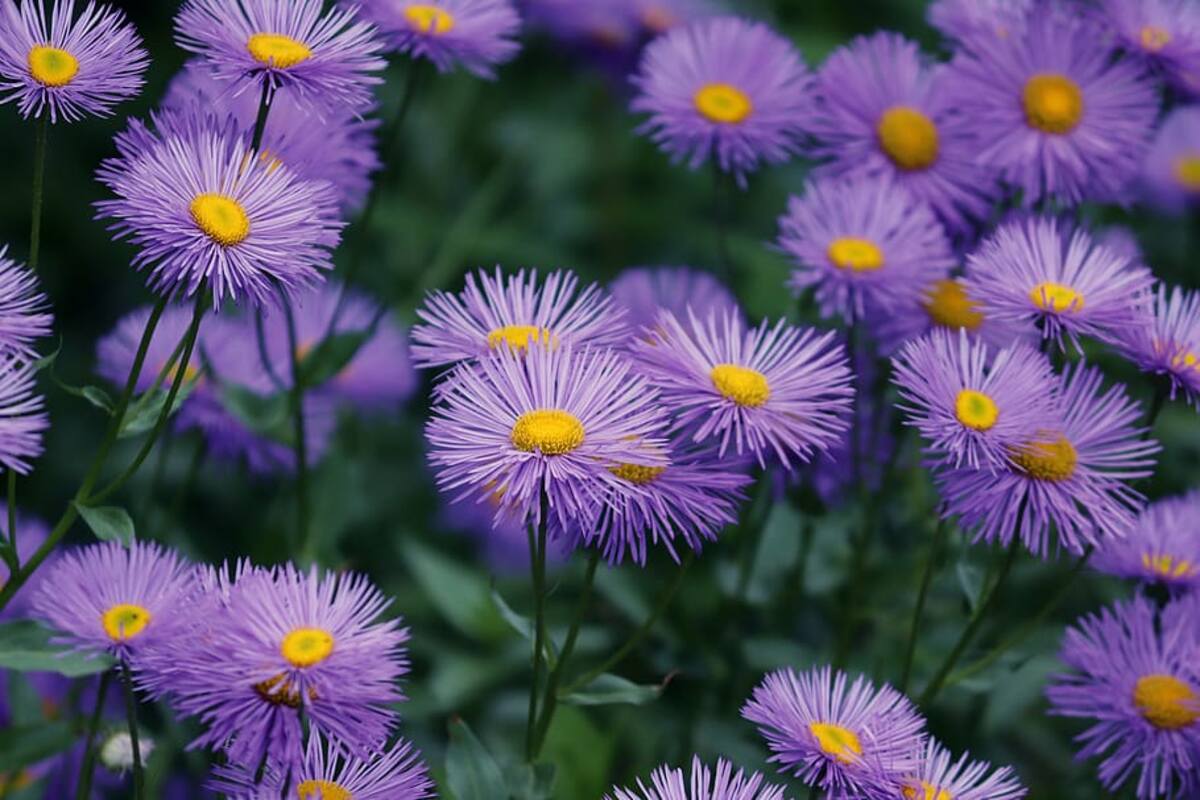
Photo Credit: pxfuel
New England aster is a big aggressively-growing flowering plant with a dense array of hairy, clasping leaves on thick stems. The abundance of bright, beautiful flowers has orange-yellow centers that bloom from the ends of the leafy branches. Its flowers vary in color, from blue or lavender to pink or white, and blooms from August to November or until the first frost.
This perennial is a host to several butterfly larvae species, while its nectar attracts bees, butterflies, and moths. This plant repels most pests but attracts beetles and is susceptible to powdery mildew. Its edible flowers can be used in salads or teas.
Additionally, the stems and roots of New England aster have medicinal properties. They can be made into poultices, with the root being used for diarrhea and fever and the whole plant for respiratory issues.
- Growth habit: Herb
- USDA hardiness zone: 4-8
- Mature size: Up to 6 feet tall
- Duration: Perennial
- Foliage: Deciduous
- Sunlight needs: Part shade
- Soil preferences: Moist, acidic (pH<6.8)
- Water needs: Moderate to high
- Potential hazards: Non-toxic – its leaves and flowers are edible
8. New Jersey Tea (Ceanothus americanus)
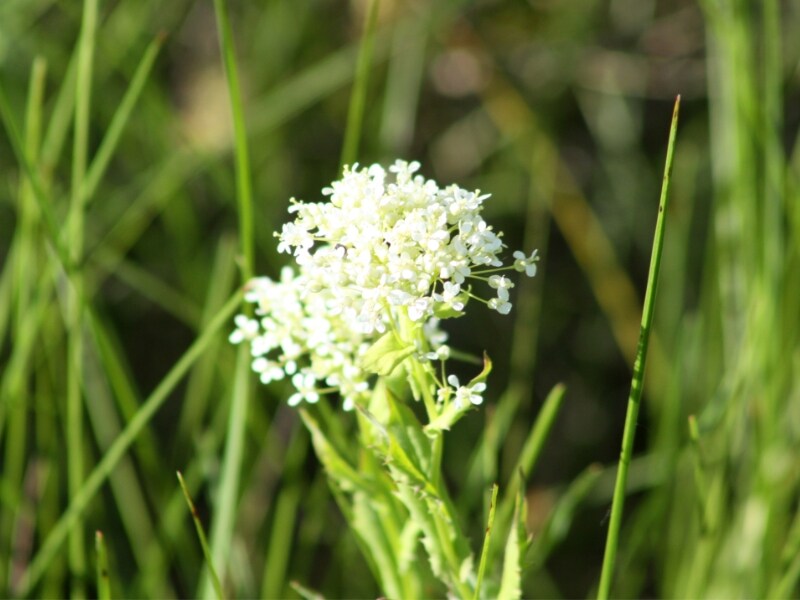
Photo Credit: Silviu Carol Cenusa / Canva Pro / License
A low-growing shrub, New Jersey tea has small green, spade-shaped leaves and 2-inch oval flower heads. Its tiny white flowers bloom in March and April. However, young leaves are grayish, giving the plant a smoky hue. While the base is woody, the upper portion is herbaceous with lovely spreading branches.
As its name suggests, the dried leaves of this deciduous shrub make an excellent decaffeinated tea. During the Revolutionary War, it was popular for treating fevers, asthma, bronchitis, and coughs. This nitrogen-loving plant’s nectar attracts bees and butterflies, and its seeds attract turkeys and quail.
- Growth habit: Shrub
- USDA hardiness zone: 4-8
- Mature size: Usually up to 3 feet but rarely up to 5 feet
- Duration: Perennial
- Foliage: Deciduous
- Sunlight needs: Sun, partial shade
- Soil preferences: Very adaptable and can grow well in well-drained, mesic sand, loam, or limey soils, as well as sandy, sandy loam, medium loam, and limestone-based soils
- Water needs: Low to moderate
- Potential hazards: Non-toxic
9. Pearly Everlasting (Anaphalis margaritacea)
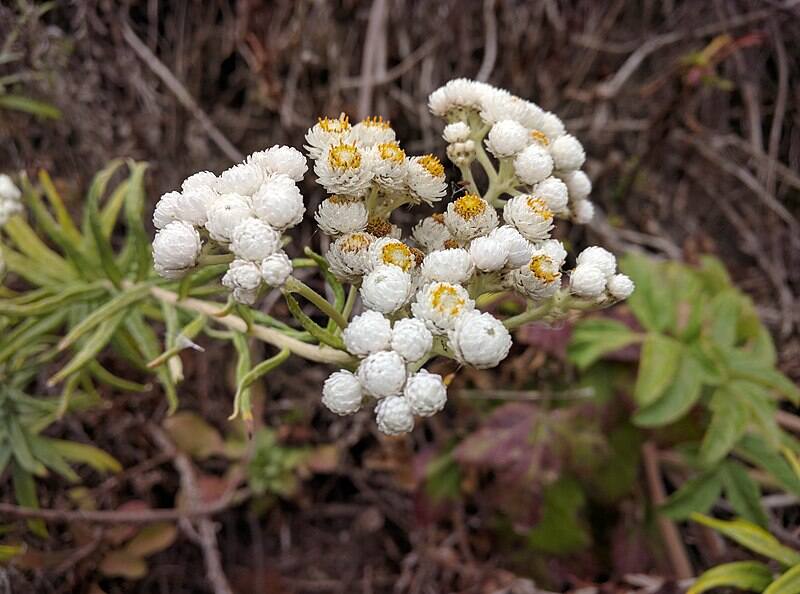
Photo Credit: Franco Folini / Wikimedia Commons / CC BY-SA 2.0
Except in the Southeast, pearly everlasting grows throughout the United States and Canada. The bushy, cottony clusters of small white flowers with yellow centers grow at the top of the stem, which is decorated with long narrow green leaves with wooly-white undersides. They’re often used as supporting characters in flower arrangements.
Pearly everlasting is a popular flower for pollinators, particularly the painted lady butterfly, which uses the plant as a host for its eggs. Medicinally, it has many uses, such as tea for excessive mucus, sore throat, and wet cough, and poultices for stiff, rheumatic joints, wounds, and blisters. It’s also used for digestive issues, including ulcers, food poisoning, and diarrhea.
- Growth habit: Herb
- USDA hardiness zone: 3-7
- Mature size: Up to 3 feet
- Duration: Perennial
- Foliage: Evergreen or semi-evergreen
- Sunlight needs: Full sun or partial shade
- Soil preferences: Prefers sandy or gravelly soils – it has a low tolerance for calcium carbonate-rich soil
- Water needs: Moderate
- Potential hazards: Non-toxic
10. Red Maple (Acer rubrum)
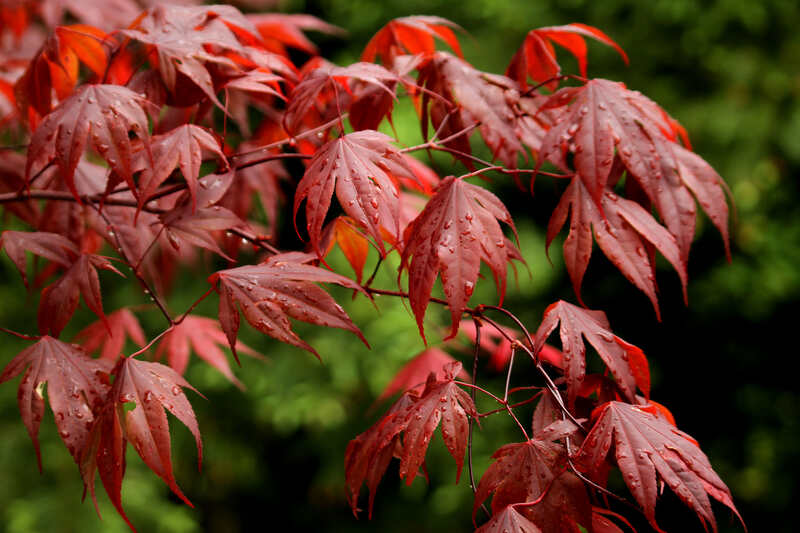
Photo Credit: Heng Wang / Wikimedia Commons / CC BY-SA 3.0
Red Maple is a popular ornamental tree in North America due to its breathtaking fiery fall color. In spring, leaves bud red before maturing to dark purplish green. In the fall, they turn shades of yellow, orange, and purple. The leaves are 3 or 5 lobed, separated by V-shaped angles. Seeds are encased at one end of a paper-thin wing that becomes helicopter-like when they fall.
A young red maple has smooth silvery bark that ages into a dark gray with vertical cracks. This shade-giving tree is a great shelter and food source for birds, squirrels, rabbits, and deer. The hardy, quickly-growing red maple is popular in lumber production due to its smooth grain pattern, durability, and light, creamy color.
- Growth habit: Tree
- USDA hardiness zone: 3-9
- Mature size: Up to 100 feet, but usually 40-60 feet
- Duration: Perennial
- Foliage: Deciduous
- Sunlight needs: Full sun, partial shade
- Soil preferences: Found mostly in swamps and moist woodlands, it prefers moist, slightly acidic soils.
- Water needs: High
- Potential hazards: Non-toxic to humans – wilted or dried leaves are toxic to horses
11. Spotted Wintergreen (Chimaphila maculata)
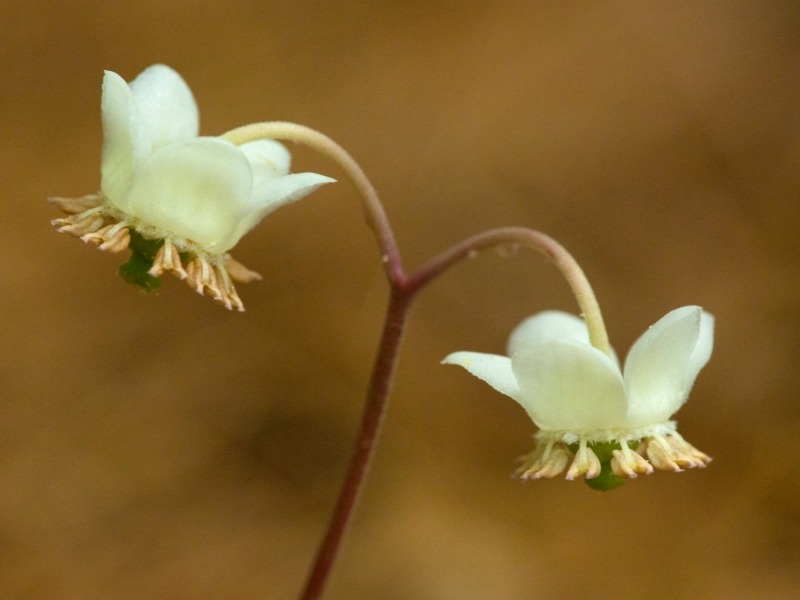
Photo Credit: Holcy / Canva Pro / License
Endangered in Canada, Illinois, and Maine, the spotted wintergreen is found in mesic habitats of the Eastern United States and Canada. The evergreen sword-shaped leaves are dark green with white veins. It has small clusters of round, drooping, waxy flowers atop the stem. Blooming from June to August, its flowers are white but sometimes have a pink, blue, or purple hue.
A member of the shinleaf family, spotted wintergreen has a delicate smell rather than a minty one. Its leaf tea can treat gallstones, kidney stones, rheumatism, inflammation, and stomach problems. Crushed leaves can create a poultice for sores and wounds. The herb attracts insect pollinators, primarily bumblebees, but is deer resistant.
- Growth habit: Subshrub
- USDA hardiness zone: 5a-8b
- Mature size: Up to 1 foot
- Duration: Perennial
- Foliage: Evergreen
- Sunlight needs: Shade
- Soil preferences: Dry, well-drained, sandy, acidic soil
- Water needs: Low
- Potential hazards: Non-toxic
12. Trumpet Honeysuckle (Lonicera sempervirens)
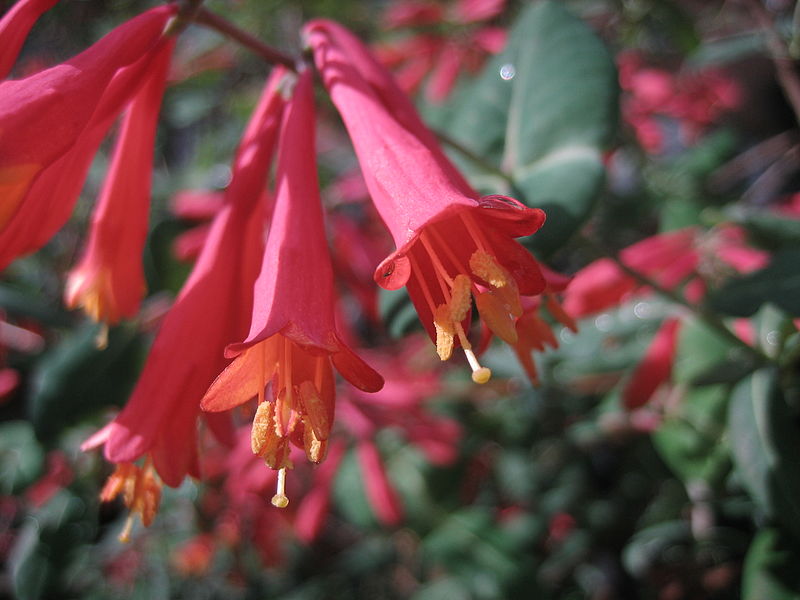
Photo Credit: Biosthmors / Wikimedia Commons / CC BY-SA 4.0
The trumpet honeysuckle is an excellent climbing or groundcover vine, perfect for trellises and arbors. Semi-evergreen leaves are smooth, glossy ovals with short pointed tips. Above the leaves are two to four showy, trumpet-shaped flowers with red outsides and yellow insides. With an orange-brown papery bark, this vine blooms from March through June and produces red berries.
The trumpet honeysuckle’s nectar attracts bees, butterflies, and hummingbirds, while the berries attract various birds. Its berries can cause an upset stomach, but the leaves have several medicinal uses – chewed leaves for bee stings, smoked for asthma, or tea for sore throat and cough.
- Growth habit: Vine
- USDA hardiness zone: 4-9
- Mature size: Up to 20 feet long
- Duration: Perennial
- Foliage: Evergreen
- Sunlight needs: Full sun, part shade
- Soil preferences: Prefers moist, rich soil but can tolerate sandy, sandy loam, medium loam, clay loam, clay, lime, and acidic soils
- Water needs: Moderate
- Potential hazards: Consuming berries is slightly toxic to humans and may cause an upset stomach.
How to Choose Native Plants for Your Massachusetts Landscape
The Bay State may be small, but that doesn’t mean it isn’t diverse. With the ocean on one side and the Appalachian Mountains on the other, planting conditions can have significant differences within a few miles.
Knowing that the USDA hardiness zone in Massachusetts ranges from 5a to 7a can help you decide which plants to choose. But if you want native plants to thrive on your landscape, you must understand your lawn’s microclimate, including soils, average rainfall, and temperatures.
Eastern Massachusetts
In the eastern coastal regions, a wealth of native plants thrives, adapting to the unique blend of sea breezes, wetlands, and well-drained soils. Embrace the coastal beauty by incorporating beach roses, bayberry, and seaside goldenrod into your garden. These resilient plants are accustomed to the challenges posed by salty air, sandy soil, and the following factors:
- USDA hardiness zone: 6b-7b
- Average lows: -5 to 10 Fahrenheit
- Annual precipitation: Ranges between 40 and 50 inches
Central Massachusetts
Central Massachusetts offers a diverse landscape with rolling hills, forests, and fertile soils. Native plants that flourish in this region include mountain laurel, flowering dogwood, highbush blueberry, and red maple. Embrace the natural charm of the area by considering the following factors:
- USDA hardiness zone: 5b-6a
- Average lows: -15 to -5 Fahrenheit
- Annual precipitation: Between 40 and 50 inches
Western Massachusetts
As you venture westward, the landscape of Massachusetts transitions to picturesque mountains, lush valleys, and pristine woodlands. Native species like sugar maple, eastern hemlock, northern maidenhair fern, and mountain ash find their home in this region. Embrace the majestic beauty of western Massachusetts by taking into account the following factors:
- USDA hardiness zone: 5a-6a
- Average lows: -20 to -5 Fahrenheit
- Annual precipitation: Ranges between 40 and 50 inches
While there are differences between Eastern and Western Massachusetts soils, most of it is Paxton soil – named after the town of Paxton (just north of Worcester). Paxton soil is coarse sandy loam with mineral deposits from various rocks, primarily schist, gneiss, and granite. It’s also loaded with rocks–great for drainage but challenging for landscaping.
Although you may live in one region, several factors, like construction, prior treatments, or weather, can make your soil different from the surrounding ground. The only way to understand your soil type and, therefore, the best native plants for your garden is to have your soil tested.
While waiting for your results, discover the best grass seed for your Massachusetts lawn and when to plant it.
FAQ About Native Massachusetts Plants
The ideal time to plant flowers in Massachusetts depends on the type of flowers you wish to plant. Massachusetts experiences a range of climates, with varying temperatures and frost patterns across the state. Generally, the planting season for flowers in Massachusetts begins in late spring and extends through early fall.
Here are some guidelines based on the different categories of flowers:
● Annuals: Annual flowers, such as petunias, marigolds, and zinnias, should be planted after the danger of frost has passed, typically in late May or early June.
● Perennials: Perennial flowers, like coneflowers, daylilies, and hostas, can be planted in spring or fall. Spring planting allows the plants to establish their root systems before the summer heat, while fall planting gives them a head start for the following growing season.
● Bulbs: Spring-blooming bulbs, such as tulips, daffodils, and hyacinths, are planted in the fall, usually between September and November. On the other hand, summer-blooming bulbs should be planted in the spring.
Native plants have evolved to adapt and thrive in the local ecosystem, developing relationships with the climate, soil conditions, wildlife, and other native species. Massachusetts has tons of native plants, according to UMass Amherst. But most native plants in the Bay State have the following in common:
● Grows in acidic soil: This is crucial since all of Massachusetts has acidic soil, some areas more than others.
● Cold tolerant: With the state’s average yearly temperature of 59.2 degrees Fahrenheit, plants must be able to tolerate the cold.
● Pest and disease resistance: Native plants resist common diseases and pests because they have developed natural immunity.
● Wildlife food source: Native plants are a source of food, shelter, and nesting sites for butterflies, bees, birds, and other wildlife.
Choosing native plants for your Massachusetts landscape offers numerous benefits, including reduced maintenance needs, enhanced resilience to local conditions, and support for local wildlife.
Massachusetts is a welcome place for pollinators, and homeowners can choose from a lot of blooming species. The following are just a few native plants that can attract pollinators in Massachusetts:
● Serviceberry
● Rhododendron
● New England aster
● New Jersey Tea
● Swamp milkweed
● White baneberry
Where to Find Native Plants in Massachusetts
Always find an ethical source like nurseries and garden centers if you want native plants in your landscape. Never remove plants from the wild. Transplanting wild plants into your yard disturbs wildlife and their habitats. It also can introduce pests and diseases to your landscape.
Once your garden is bursting with beautiful native plants, don’t neglect your lawn. Whether you’re in Boston, Worcester, Springfield, Cambridge, Lowell, or somewhere in between, Wikilawn can connect you with a highly-rated lawn care professional to handle lawn care for you.
Main Photo Credit: OlegAlbinsky / Canva Pro / License